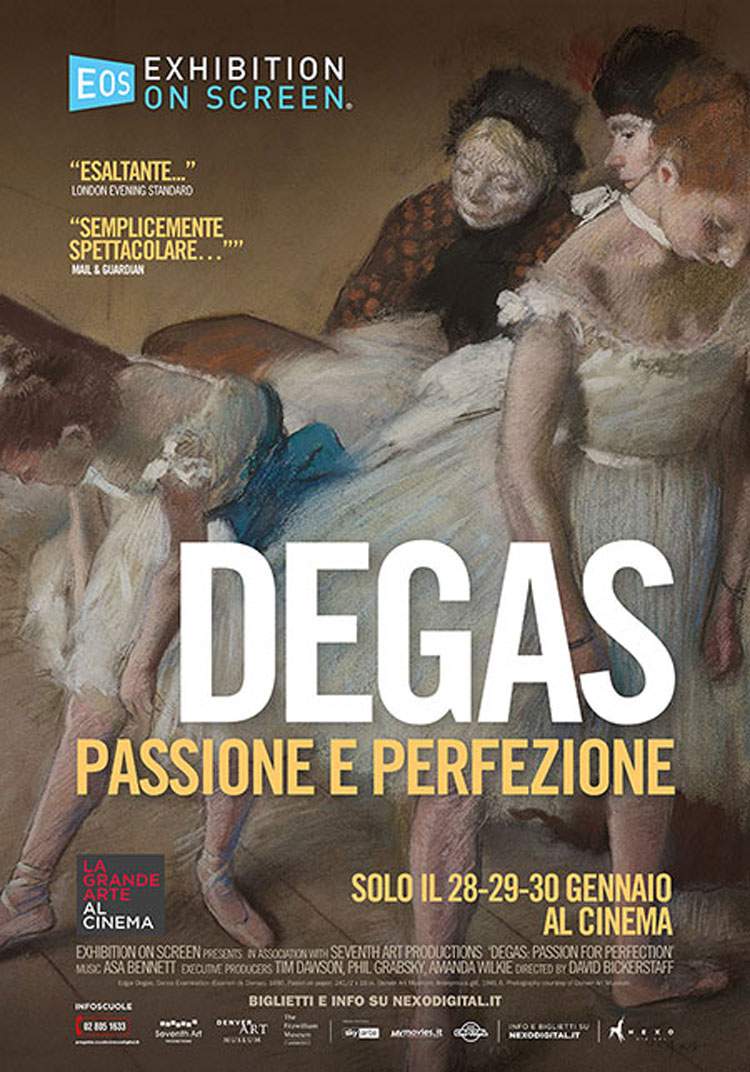On January 28, 29 and 30, 2019, the new docufilm in the"Great Art at the Movies" cycle will arrive in Italian cinemas. It will be dedicated to one of the most beloved and independent personalities of the Impressionist movement - Edgar Degas.
Degas. Passion and Perfection, this is the title of the event film directed by David Bickerstaff that opens the 2019 season of Nexo Digital’s initiative.
Viewers will traverse the halls of the Fitzwilliam Museum in Cambridge, home to the largest Degas collection in the United Kingdom, and then travel to Paris and Italy, where Degas spent his formative years and where he was also able to reconnect with his paternal grandfather, René Hilaire De Gas, who moved to Naples following the French Revolution.
A unique insight into Degas’s personal and creative life will investigate his relationship with the Impressionist movement, his fascination with dance and the vision problems that plagued him since the 1990s. His obsessive pursuit of perfection through experimentation with new techniques and the study of past masters, including Italian Renaissance artists and contemporary painters such as Ingres and Delacroix, will also be analyzed. It was a study that began as early as his personal Grand Tour to Italy and developed year after year through constant frequentations of Parisian galleries and museums, foremost among them the Louvre.
As the French historian Daniel Halévy explains, Edgar Degas (1834-1917) was a tireless and almost always dissatisfied worker who kept most of his works hidden in boxes: he extracted them only when he was forced to sell them for a living. Degas, whom friends described as a brilliant man capable of releasing cheerfulness but also terror in those around him, was an artist interested more in the artistic process itself than in the end result, so much so that he was known for obsessively reworking his works. It was a mania that, on some occasions, even led him to ask clients to have his paintings back so that he could further retouch them even after he had delivered them.
In order to depict the everyday life that so affected him, such as life in Parisian cafes, horse races, family portraits, and female nudes, Degas did not limit himself to painting but also made numerous statues, though he preferred wax or clay: He claimed he could leave nothing behind in bronze because “metal was for eternity.” Art dealer Ambroise Vollard recounted how one day Degas showed him a ballerina he had retouched for the twentieth time, exclaiming, “I would not exchange even for a bucket of gold the pleasure I feel in destroying it and starting over.”
When Degas died in 1917, more than 150 sculptures in wax, clay and plasticine were found in his studio, many of them preserved right at the Fitzwilliam Museum. It will be these sculptures, along with a study of some of his most famous paintings, the accounts of those who were close to him, and his own letters, that will reveal the complex interiority of one ofImpressionism’s most influential and beloved artists.
Great Art at the Movies is an original and exclusive project of Nexo Digital. For the 2019 season it arrives in Italian theaters in collaboration with media partners Radio Capital, Sky Arte and MYmovies.it.
 |
| The 2019 season of The Great Art at the Movies begins with Degas |
Warning: the translation into English of the original Italian article was created using automatic tools. We undertake to review all articles, but we do not guarantee the total absence of inaccuracies in the translation due to the program. You can find the original by clicking on the ITA button. If you find any mistake,please contact us.